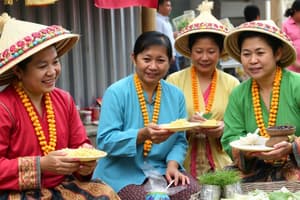Podcast
Questions and Answers
What was the government called during the pre-Spanish era in the Philippines?
What was the government called during the pre-Spanish era in the Philippines?
- Hacienda
- Barangay (correct)
- Galleon
- Encomienda
Who headed the Barangay during the pre-Spanish era?
Who headed the Barangay during the pre-Spanish era?
- The Datu/Raja (correct)
- The Cabeza de Barangay
- The Encomendero
- The Sultan
How was the succession of leadership determined in the Barangay during the pre-Spanish era?
How was the succession of leadership determined in the Barangay during the pre-Spanish era?
- The Datu would appoint a successor from among the freemen.
- The eldest son of the Datu would succeed him, or the strongest in the tribe if there was no son. (correct)
- The leadership would be determined by a vote among the nobles.
- The Datu's position was not hereditary, and a new leader would be elected by the entire Barangay.
What were the two strategies used by the Spaniards to conquer the Philippines?
What were the two strategies used by the Spaniards to conquer the Philippines?
Which of the following was NOT a form of resistance against Spanish colonial rule mentioned in the text?
Which of the following was NOT a form of resistance against Spanish colonial rule mentioned in the text?
What were the two factors that contributed to the development of the concept of the Filipino identity?
What were the two factors that contributed to the development of the concept of the Filipino identity?
Flashcards
What is a Barangay?
What is a Barangay?
The basic autonomous political unit during the pre-Spanish era in the Philippines.
Who is the Datu/Raja?
Who is the Datu/Raja?
The leader of the Barangay, responsible for lawmaking and governance.
Barangay succession
Barangay succession
Leadership was typically passed down to the eldest son or, in his absence, to the strongest member of the tribe.
Spanish Conquest Strategies
Spanish Conquest Strategies
Signup and view all the flashcards
Filipino Identity Factors
Filipino Identity Factors
Signup and view all the flashcards
Study Notes
Pre-Spanish Era
- The government was called Barangay, headed by the Datu/Raja, considered the king of the barangay.
- Barangay was considered a kingdom or country, with no national government.
- The Datu's eldest son succeeded him, or the strongest in their tribe or barangay if there was no son.
Social Classes
- Nobles: highest social class
- Freemen: second social class
- Slaves: lowest social class
Spanish Colonial Rule/Experience
- Lasted for 333 years
- 2 strategies used by the Spanish to conquer the Philippines:
- Physical Control: forced small communities to form larger ones for control and proselytization (reduction)
- Psychological Control: manipulation
Forms of Resistance
- Nativism: revolt against the Spanish through fighting with one's own faith
- The Growth of Local Clergy: revolt of local Filipino priests for equal rights (GOMBURZA)
Elite Participation in the People's Protest
- Inconsistent pattern of elite participation in protests against Spanish oppression
- Some elites did not support their own country for selfish gains
Development of the Filipino Concept
- Opening of the Philippines to international trade
- Rise of the middle class, leading to the development of the concept of the Filipino
Studying That Suits You
Use AI to generate personalized quizzes and flashcards to suit your learning preferences.




